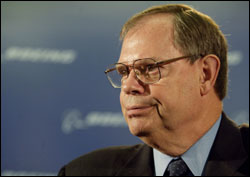Over the seven years of Phil Condit’s reign as chief executive officer of Boeing, I can’t think of a time when there wasn’t some sort of crisis under way, or some imminent challenge that was being compared to that of the late 1960s, when Boeing executives correctly bet the company on the potential success of the 747 a business decision and engineering accomplishment that set Boeing’s gold standard of glory. This is not to say that Boeing never had problems before, but in the years since Condit was appointed CEO in 1996, negative or skeptical headlines have been numerous and glory has been elusive. If it wasn’t a strike, it was a suspect plane crash or a dumpy stock price or poor manufacturing quality. A rocket blew up. Then the commercial-space market for launches and satellites, on which Boeing gambled, imploded. The company lost a bid to be lead contractor for the next generation of jet fightera prize worth billions and won by archenemy Lockheed Martin. A space shuttle burned up on re-entry, and while that was ultimately NASA’s fault, Boeing decisions and engineering played a role in the disaster. The company won the nation’s spy-satellite contract, which Lockheed had held for 40 years, but word has it that Boeing has blown that opportunity, too. And so on.
So Condit’s legacy was certain even before the ethics scandal of 2003 prompted his resignation this week: Ambitious acquisition and diversification merely brought more and diverse problems. The CEO and chairman of the board was responsible for confronting all those problems and more, and in the end he fell on his sword. But the world isn’t so simple. No single lapse was Condit’s fault. In business, as in engineering, complexity and human nature often collide and confound any leader’s best intentions, and in doubling the size of Boeing, Condit had created a monster.
The focus on growing and diversifying the business during Condit’s leadership was so distracting that the company stumbled big-time in the one sector it already ruled. Boeing had amassed a record backlog of airplane orders in 1997, but the boom coincided with an efficiency campaign that had just reduced the number of experienced factory workers and parts suppliers. In the months it took to fully sort out the mess in the Everett and Renton plants, the Commercial Airplanes division was about as inefficient as can be. It had to shut down the 747 and 737 assembly lines for a month, and Boeing posted a loss that year of $178 million. Eventually, Boeing did streamline production, delivering 620 planes in 1999, a record. But then came 9/11 two years later. Today, with no end to the air-travel downturn in sight, Boeing expects to deliver only 280 planes in 2003, the fewest since 1996. As CEO, Condit lasted exactly one bust-boom-bust cycle in the predictably up-and-down airplane business. Same with Boeing’s stock price, which is virtually the same today as when Condit took over.
IT’S AS IF NOTHING happened during the past seven years, yet so much did. Before Condit, Boeing did some military and space work, but until it acquired Rockwell in 1996 and merged with McDonnell Douglas in 1997, Boeing was primarily a commercial-airplane company. Commercial air travel is still one of life’s nonessentials, so the health of the economy at any given moment dictates the revenue from passenger planes. The space and defense assets of Rockwell and McDonnell Douglas were supposed to diversify Boeing, to offset the cyclical airplane business, to smooth out the revenue stream. So was the company’s foray into so-called aircraft services, like financing, refurbishment, air traffic control, and airborne Internet connectivity. And yet a chart of Boeing’s stock price between then and now has many altitudesas high as $69 (2000) and as low as $25 (2003). Under Condit, as a diverse and global $50 billion-a-year aerospace behemoth, the company was as bipolar as ever. In contrast to the volatile dot-coms of the late 1990s, Boeing actually made stuff and actually made money doing it. It was supposed to be a slow but steadyand safeinvestment. It hasn’t been. Boeing is merely bigger, which might be why a certain person couldn’t successfully manage the company he created.
Condit, 62, began as a young engineer at 24 and worked on just about every airplane program except the 747. He earned his reputation of capability in managing complex projects through key roles in development of the 757 and 777. The Boeing he knew then, the company that nurtured him, was far different than the company he later created as CEO. It was focused on building jetliners, and it dominated that industry, cyclical though it was. If the rough period starting in 1997 was anomalous, one wonders what Boeing would be had it not ventured into other areas of aerospace. The commercial- airplane business today is profitable, while the defense and space businesses struggle. Condit has said it would have been folly to not expand the company, but I wonder.
While that expansion was under way, Airbus, the European commercial-airplane consortium, was grabbing market share. Airbus marketers taunted Boeing as they began to win over traditional Boeing customers. Boeing finally gave up complaining that Airbus, subsidized by its sponsoring governments, was competing unfairly, selling planes at little or no profit. Sometime during the Condit years, it ceased to matter whether Airbus played fair or not. Remember those bumper stickers, “If it’s not Boeing, I’m not going”? It was the ultimate irrationality of Boeing engineers and mechanics during the rise of Airbus. No one outside three Western Washington counties cares what kind of plane they’re on, if they can even identify it. The fact is Airbus planes are excellent products. While Boeing sought new frontiers in defense and space, its core competency, commercial transports, was eclipsed by European engineers, born of World War II, who had been liberated in part by B-17s Boeing built on East Marginal Way South.
For a long time, the Boeing “family” here tried to wish it were not so. Business sense finally prevailed. The company decided that if it could no longer be No. 1 in jetliners, it would at least be a profitable No. 2. That mission was accomplished, but who can take credit for making it happen? Probably Commercial Airplanes President Alan Mulally and thousands of others. That division succeeded in spite of Condit’s diversification and growth strategy, not because of it.
CREDIT and blame are squishy concepts in a complex organization. An individual’s influence is hard to calculate in big business, just as it is hard to account for one person’s role in mustering the brainpower necessary to engineer a complex technology. A walk through a Boeing airplane factory, whether here or in St. Louis, where the jet fighters are made, is at once awesome and shocking. It’s awesome that so many people, no one of them knowing the full picture, can design and build such complicated machines, that the machines can be mass-produced, and that the machines rarely fail. It is also shocking that no one person understands it all. We want there to be a grown-up who knows how all the pieces fit together, who knows where all this is leading us. But who can keep track of it all? Condit couldn’t, obviously. It might be that a company as big as Boeing can’t be led anywhere in particular.
As the world’s biggest aerospace company, second only to Lockheed Martin in U.S. defense contracts, Boeing still rules the skies and space, having delivered 14,705 jet- powered passenger planes, having helped send men to the moon and helped build the international space station, having designed and supplied much of the high-tech weaponry that makes it possible to wage war with minimal loss of American lives, and having swallowed competitors along the way. It would seem that being a company town would be a pretty good deal if that company were Boeing. And yet it hasn’t seemed so good since Condit took Boeing big-time, what with tens of thousands of layoffs, the move of corporate headquarters to Chicago, and the blackmailing of the state government this year, during which Boeing held a measly 1,200 7E7 factory jobs hostage for $3.5 billion in tax breaks and other incentives. Boeing has outgrown us. The funny thing is that Condit, the man who led the company through the growth that ate him and us, says he is looking forward to returning to little ol’ Seattle. As he passed the torch to Harry Stonecipher, the former chief operating officer who has cancelled his retirement to run the company, Condit looked downright relieved and cheerful on CNBC the other day. Maybe he liberated us by moving the company to Chicago, then liberated himself.
Chuck Taylor is Seattle Weekly‘s managing editor and covered aerospace for The Seattle Times from 1997 to 2001.






